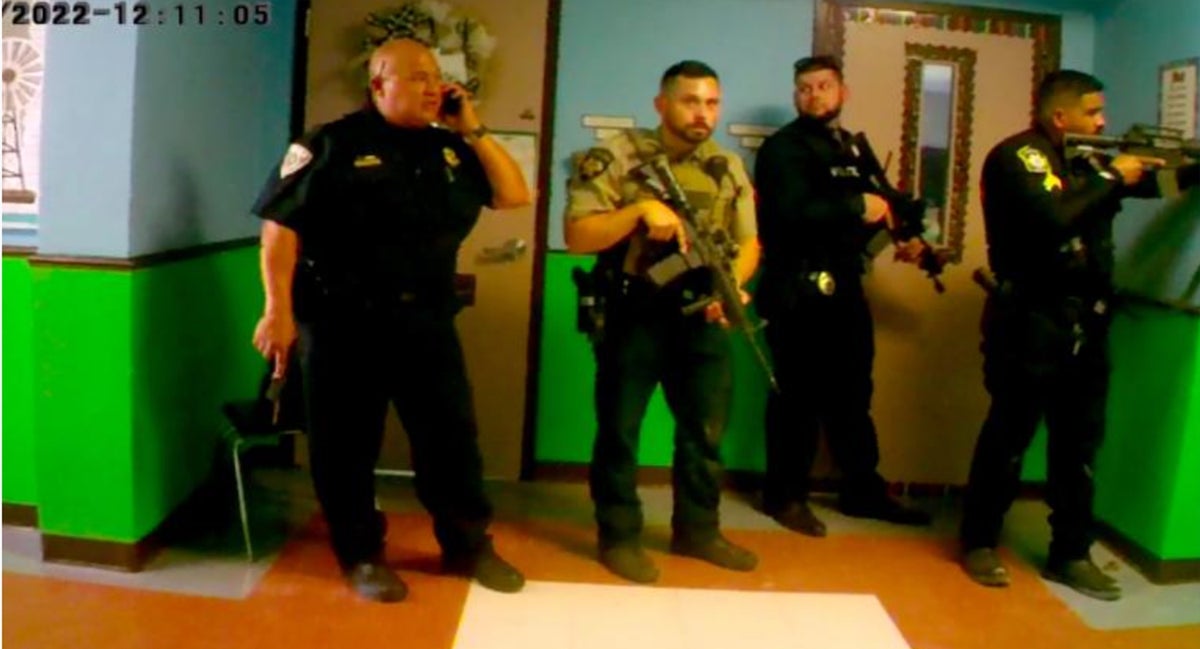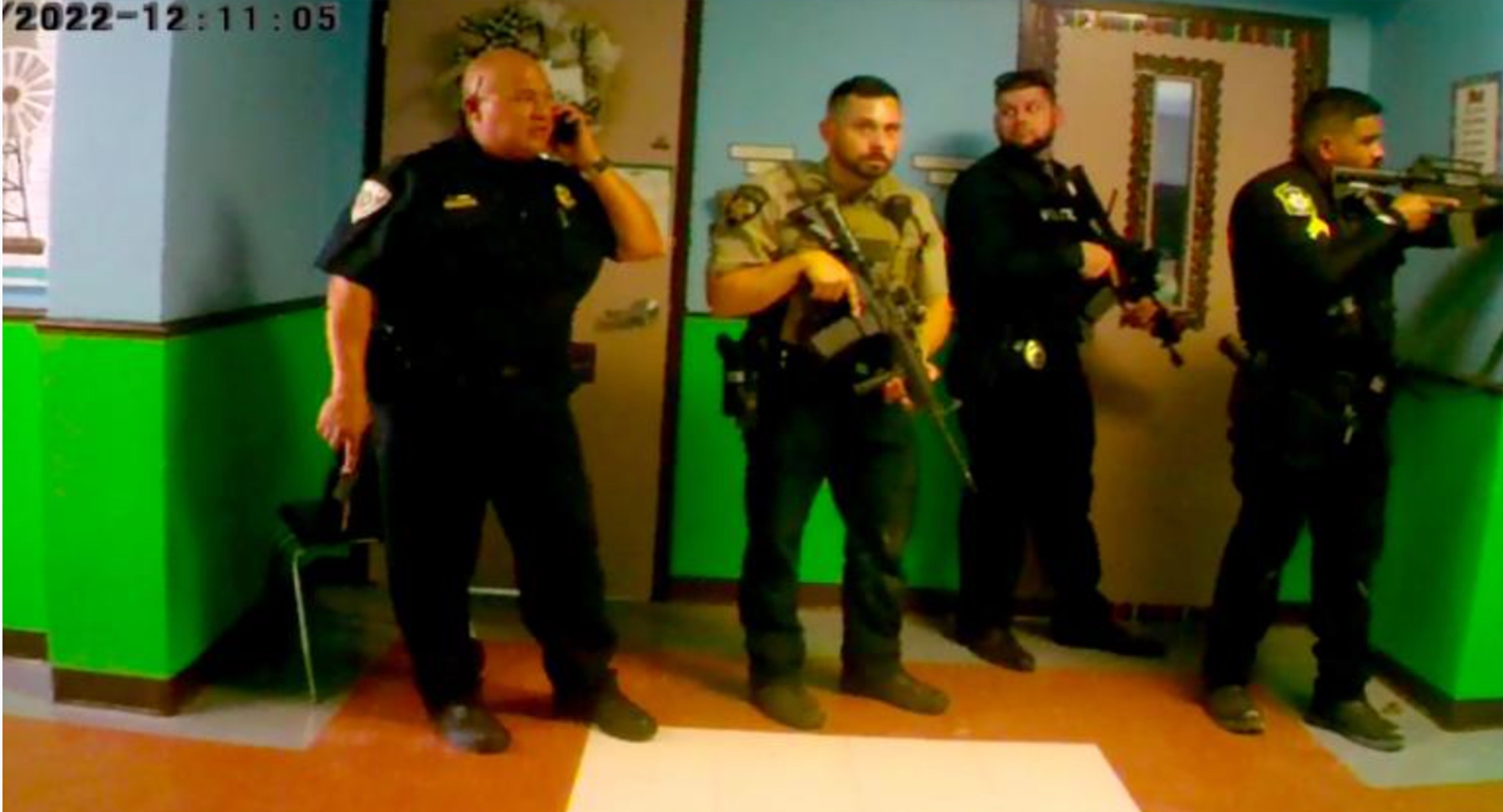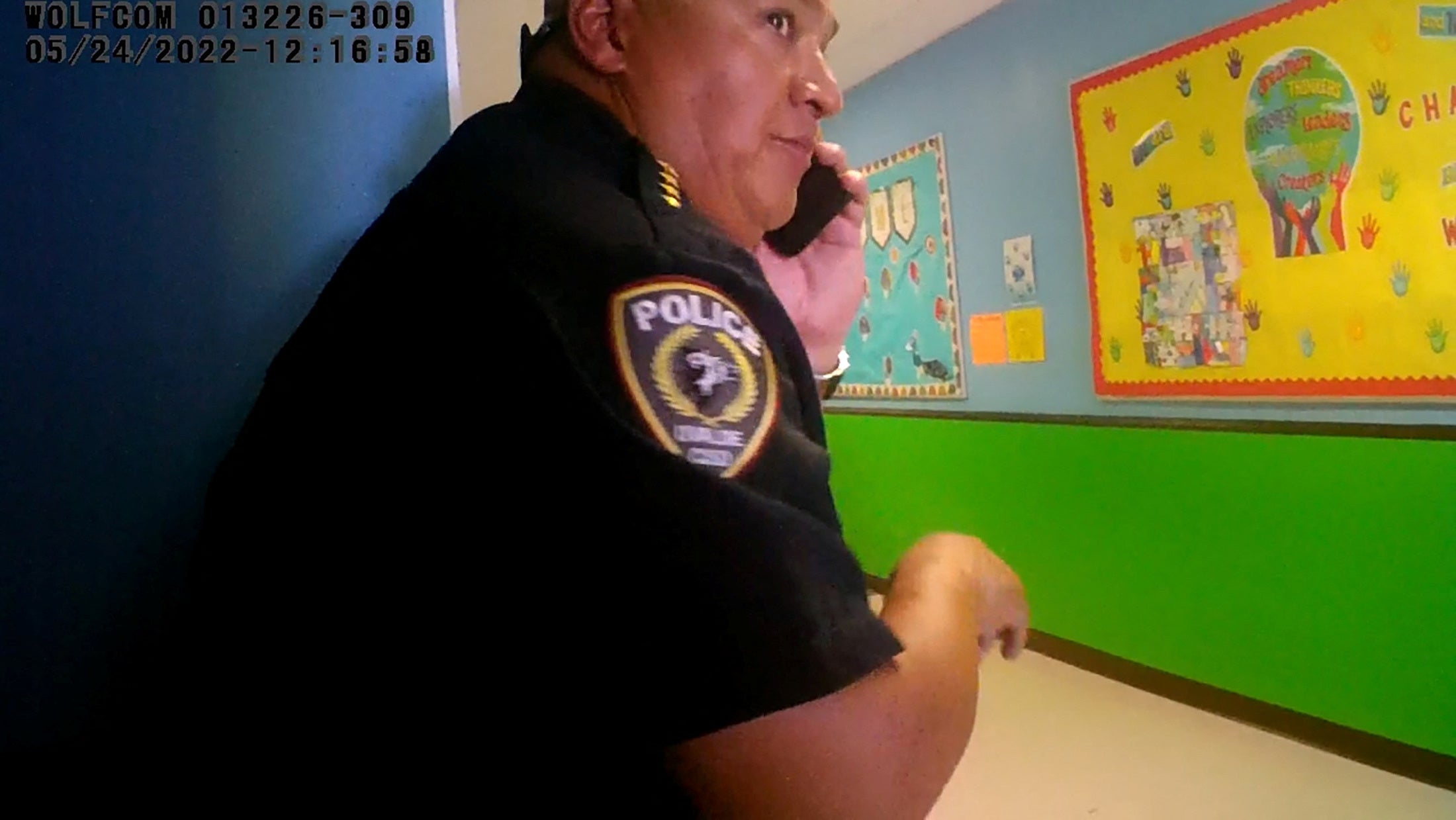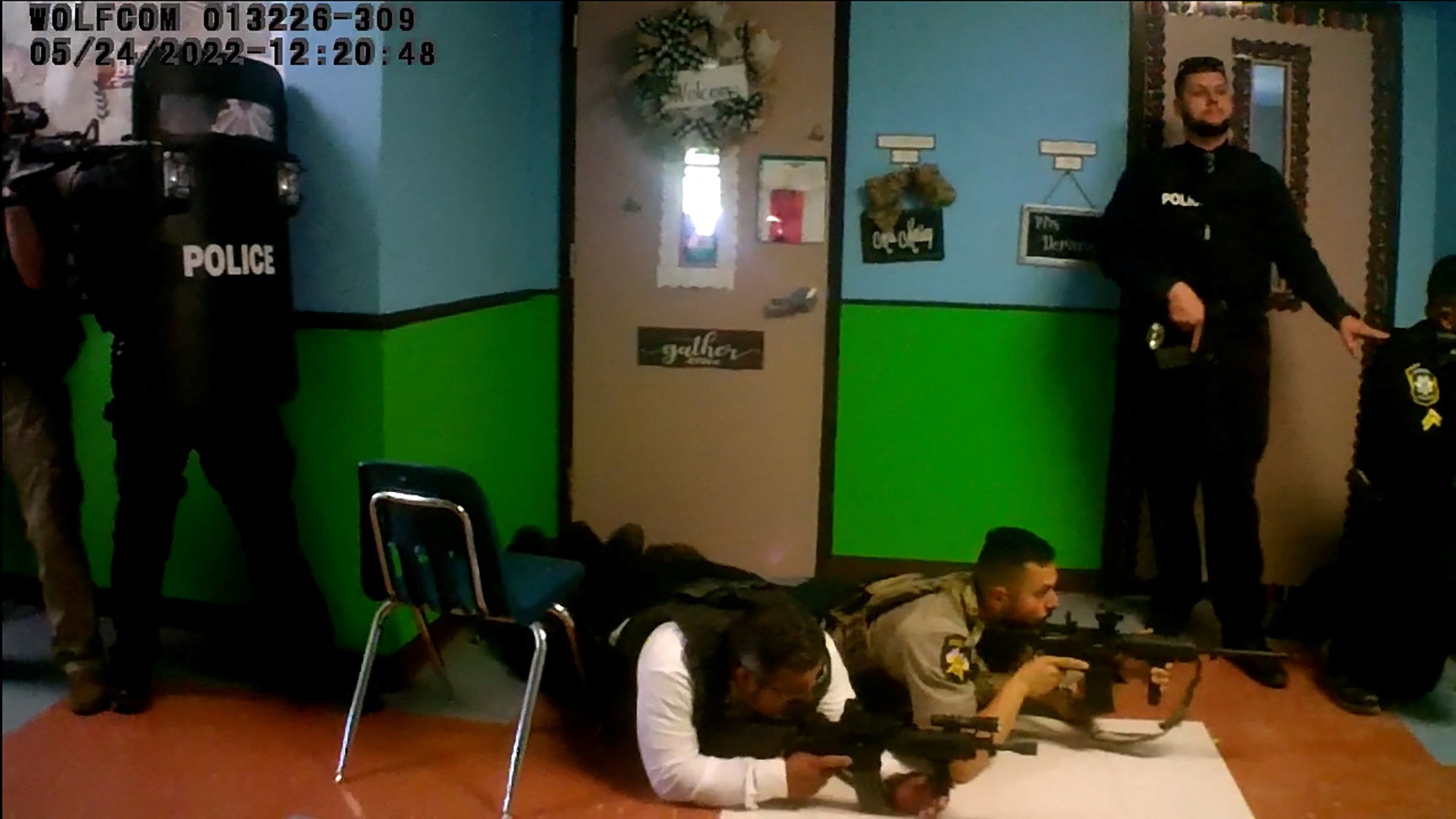
Newly-released bodycam footage from the Uvalde mass shooting has revealed how the school police chief repeatedly tried to negotiate with the gunman through the classroom wall as he continued to shoot and kill innocent victims inside.
The video captures Uvalde School Police Chief Peter Arredondo standing with other officers in the hallway at Robb Elementary School making multiple attempts to engage Salvador Ramos.
The 18-year-old mass shooter did not respond to Chief Arredondo once.
The city of Uvalde released bodycam footage from seven law enforcement officers on the scene of the 24 May massacre on Sunday night – hours after a bombshell report concluded that local, state and federal law enforcement had a “lackadaisical” response that day where they “failed to prioritise saving the lives of innocent victims over their own safety”.
The footage reveals a chaotic and disorganised scene where almost 400 law enforcement officers from multiple agencies failed to stop the gunman for more than 77 minutes after he first entered the school and began his slaughter of innocent students and staff.
In the bodycam video from one officer, Chief Arredondo is seen trying to talk to Ramos through the wall at 12.11pm – almost 40 minutes after the gunman first opened fire on his victims.
He tells Ramos that “this could be peaceful” while multiple heavily armed officers stand by, none of them breaching the classroom.
“Let me know if there’s any kids in there or anything,” he shouts.
“This could be peaceful. Can you tell me your name, anything I can know please?”
Separate bodycam footage reveals that – just seconds after this attempted interaction – a 911 dispatcher announces over the police radio that a child had called 911 from inside the classroom.
The boy told the dispatcher that they were “in a room full of victims”.
It is unclear if the chief – who was the on-site commander that day – was aware of the 911 call. He did not have his police radio on him at the time and has previously claimed he did not know about the call.
The information was relayed to acting Uvalde Police Department Chief Mariano Pargas, who gave no audible response.
At 12.18pm, Chief Arredondo is then seen fumbling with keys to try to open a classroom door.

Three minutes later – at 12.21pm – several more rounds of gunfire are heard ringing out from inside the classroom.
Despite the ongoing assault, no officers enter the classroom and – two minutes later – Chief Arredondo again tries to speak to the gunman.
“Sir, if you can here me please put your firearm down sir,” he shouts.
“We don’t want anybody else hurt.”
Another officer is heard questioning the inaction going on all around, saying: “We got kids in there.”
Another voice replies: “I know, I know that’s why we’re trying to get ‘em out.”
It was another almost 30 minutes before officers finally entered the classroom and shot Ramos dead.
Frustration with the slow response and an awareness that action was urgently needed was heard being voiced by multiple officers at various points in the bodycam footage.
The first officers arrived in the hallway of the school just three minutes after Ramos opened fire inside the school.
Bodycam footage from one of those officers reveals how they approached the classroom but quickly retreated when the gunman fired at them through the classroom wall.
As the officer retreats, he touches his ear and the footage reveals his hand covered in blood from where he was grazed by a bullet.
The officer tells other officers: “We got to get in there. He’s still shooting. We gotta get in there.”

However that sense of urgency was soon lost as another one hour and 14 minutes passed before an elite Border Patrol Unit entered the classroom.
The footage captures other officers questioning the inaction.
“What are we doing here?” one officer asks around 20 minutes into the massacre.
“People are gonna ask why we’re taking so long,” another said almost an hour after the shooting unfolded.
Other bodycam footage also shows an officer smashing a classroom window to rescue students from the mass shooting.
The young children are helped through the broken window and urged to run to waiting officers.
The scathing report released by the Texas House committee on Sunday has condemned the hundreds of law enforcement officers and multiple agencies who all failed to take action that day.
While much of the blame for the police response has been levelled at local police – in particular Chief Arredondo – the committee report found that state and federal law enforcement also shared the blame for the botched response.
Chief Arredondo’s six-member police team was vastly outnumbered by personnel from other agencies and other officers could – and should – have stepped up and taken over as incident commander when it was clear he was not up to the task, the report found.
A staggering 376 law enforcement officers descended on Robb Elementary School to respond to what became the worst mass shooting in Texas history.
Among them was 149 US Border Patrol, 91 state police, 25 Uvalde police officers, 16 sheriff’s deputies and five Uvalde school police officers.

The remaining were federal Drug Enforcement Agency officers, US Marshals and police officers who responded from neighbouring counties.
“These local officials were not the only ones expected to supply the leadership needed during this tragedy,” the report states.
“Hundreds of responders from numerous law enforcement agencies — many of whom were better trained and better equipped than the school district police — quickly arrived on the scene.”
These other officers “could have helped to address the unfolding chaos” but “no responder seized the initiative to establish an incident command post”, the report states.
“There was an overall lackadaisical approach by law enforcement at the scene. For many, that was because they were given and relied upon inaccurate information. For others, they had enough information to know better,” the report states.
In its scathing conclusion, the committee report said that it is “plausible” that this delay cost the lives of some of the victims who were bleeding out and trapped inside the room with the gunman.
“Given the information known about victims who survived through the time of the breach and who later died on the way to the hospital it is plausible that some victims could have survived if they had not had to wait 73 additional minutes for rescue,” the report stated.
Later on Sunday, the city of Uvalde announced that Chief Pargas had been placed on leave while an investigation was carried out into his response.
Prior to the report’s release, Chief Arredondo was the only law enforcement officer known to be on leave. Family members of the victims and Uvalde community members have called for him to be terminated.
The Texas House committee slammed the “lackadaisical approach” of law enforcement and said that “systemic failures and egregious poor decision making” had hampered the response to the 24 May mass shooting.
As well as the failings of law enforcement, it cited multiple failures from almost all authorities involved including the Uvalde school system, the shooter’s family and social media platforms.
The report criticised the school safety protocol, with doors repeatedly left open and unlocked, and emergency alerts not taken seriously.
On the day, unlocked doors enabled the gunman to enter the school building with ease.

The report also found that some staff didn’t take the intruder alert seriously because there had been 47 lockdown events since February – 90 per cent of them involving nearby immigration-related police chases and not being related to school violence.
The alert system itself was also criticised with no lockdown communicated over the school intercom system.
The committee also said that there were multiple warning signs that Ramos would go on to carry out mass violence but his behaviour was never reported to authorities.
In the months leading up to the attack, Ramos had earned the nickname “school shooter” on social media, became interested in violent sex and was fired from two jobs including one for harassing a female coworker, the report found.
When he was still 17, Ramos bought a trove of ammunition after family members refused to buy him a gun.
As soon as he turned 18 on 16 May, he began buying firearms with his uncle driving him to the gun store twice to pick them up. It was just eight days after his birthday that he carried out the attack.
Following the massacre, officials then undermined the public trust in the investigations by giving a “false narrative” about what happened, the report found.







